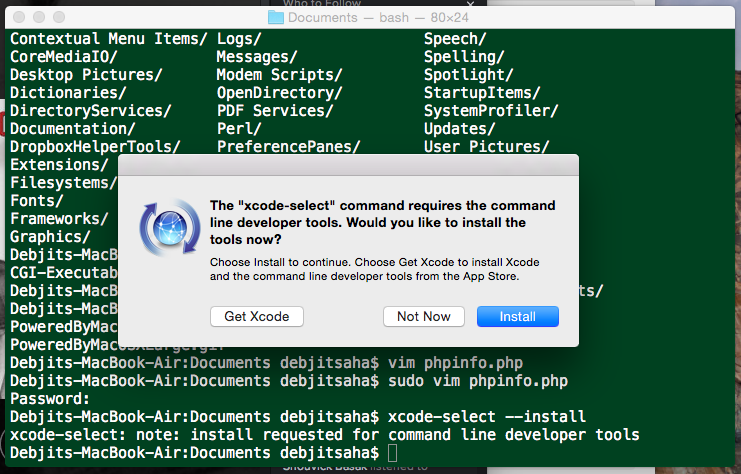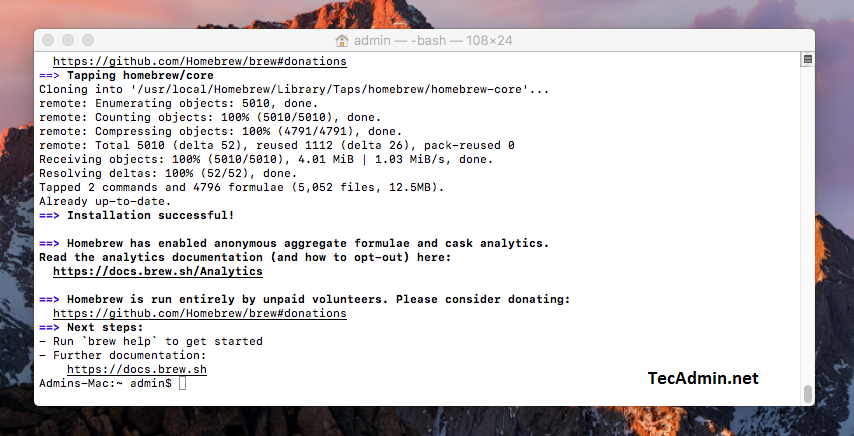Homebrew for OS X is a command line program manager, similar in functionality to “apt-get” found in some Linux distributions. By itself, Homebrew offers a user the ability to install (and update) a good number command line programs for Unix. Cask allows you to easy install Mac OS GUI apps and binaries directly from the command line. For the macOS platform, you can install the Azure CLI with homebrew package manager. Homebrew makes it easy to keep your installation of the CLI update to date. The CLI package has been tested on macOS versions 10.9 and later. Homebrew is the easiest way to manage your CLI install.
Welcome back to another SecuringNinja tutorial. No cyber security researcher should be with out a database to practice their skills on, or just to store tons of relational data. Today we will show you how to install MySQL on a Mac. Having a local database is perfect for running websites locally, or for providing persistent storage for another application.
In this article we cover how to:
Homebrew tutorial: How to use Homebrew for MacOS The open source Homebrew package manager gives Mac users access to Unix command-line utilities that Apple left out — and a lot more. If you want to install java 7 (along side java 8) via homebrew, the command is brew tap caskroom/versions followed by brew cask install java7. – icfantv Jan 19 '16 at 20:18 2 jenv is a very convenient tool for managing multiple versions of Java, either globally or locally per-directory.
MySQL is very straight forward to install on a Mac. If you do not already have the Homebrew package manager for Mac you’ll need to install that first. If you would rather not install Homebrew you can also install MySQL using the DMG file available on the MySQL site.
Installing Homebrew on Mac
Lets start by opening up Terminal and installing Homebrew. Homebrew is a macOS package manager that makes installing packages on macOS a breeze.
To install Homebrew on Mac run the following command:
Once the install is complete go ahead and run an update to test that everything is working correctly.

With Homebrew installed it is a simple matter to install MySQL.

Installing MySQL on Mac with Brew
Installing MySQL with Brew is a breeze. All it takes is:
This will install the most recent version of the package available on Brew. As of this writing it is MySQL version 8.0. To install a different version simply append the version to the end of the package with an @ symbol. For example, to install MySQL 5.7 use:
If you don’t want to install Homebrew you can also install MySQL with the DMG file available for download as described below.
Installing MySQL with a DMG file

You can also install MySQL via the DMG file on the MySQL downloads page. This will add a MySQL preference pane in System Preferences as well. You can start and stop your server from here too.
First begin by downloading and mounting the DMG file available from the MySQL Community downloads page. Make sure you grab the appropriate DMG for your OS version.
Mount the DMG and double click the .pkg file to begin the installation.
Step through the installer installer and make a note of your temporary root password. You will need this for the initial connection to the server. DO NOT LOSE IT!
The server will require that you update your password on the first login. MySQL server is now installed. To start the server use launchctl or the MySQL preference pane in System Preferences. The server uses very few resources while running in the background so there really is no need to start and stop the server each time.
Mac Brew Update
To start the server via launchctl:
This instructs MySQL to start when the system boots up.
You can also start and stop MySQL through the System Preferences pane. Open System Preferences and select MySQL:
And finally, start or stop the server as needed.
From this preference pane you can also edit the MySQL server configuration, re-initialize the database, and uninstall MySQL server entirely. We cover how to uninstall MySQL on Mac in the next section.
Uninstalling MySQL on Mac
If you installed MySQL via the DMG file method then uninstalling is extremely straight forward. Navigate to the MySQL preference pane in System Preferences, and click Uninstall. Thats it! MySQL has been uninstalled.

If you however installed MySQL using the Brew method described above, then there are a couple of extra steps.
Uninstalling MySQL on Mac with Brew
The steps below show how to uninstall MySQL installed with Brew. Begin by finding any running MySQL processes and stopping them. Then uninstall MySQL and remove all files.

What to do with your new database
Now that you’ve got a local database up and running you may want to take a look at how a SQL injection attack works. Your new database will be great for practice! If you have any issues getting your database up and running, please reach out in the comments below. We would love to assist you!
This post is out of date and has been archived. Don’t say I didn’t warnyou!
If you haven’t manually updated your version of Bash or Zsh on OS X, chances are it’s out-of-date. Here’s how to install the latest version and keep your shell updated using Homebrew.
OS X ships with an outdated version of Bash as its default shell. The preinstalled version dates back to 2007, and since then, Bash has been updated to add features and fix troublesome bugs. If you want to use an updated version of Bash—or even Zsh—as your shell, you can install it by using Homebrew, a package manager for OS X.
Installing via Homebrew
Mac Brew Java
To get things started, you need to tell Homebrew to install the latest version of your shell. Whether you prefer using Bash or Zsh, the following instructions will work for both. Just change the word bash to zsh, and you’ll be good to go.
Open your terminal and enter this command:
Homebrew installs packages to /usr/local/bin/, so you’ll need to specify that path when looking for any Homebrew packages. In the following three commands, we’ll initiate a shell as the root user, append our desired shell’s path to a file of whitelisted system shells, and then change the system shell globally.
Example
Now you can close and reopen your terminal. With just those few commands, you should be using with the latest version of your shell. You can double-check the version you’re using with the command echo $BASH_VERSION. Or, if you’ve installed Zsh, you can use the command echo $ZSH_VERSION to do the same.
Brew Command For Mac Commands
That’s it for installing your brand-new shell. Let’s take a look at how to keep it up-to-date with the help of Homebrew.
Staying current
Mac Brew Command Not Found
The Homebrew command update actually refers to updating Homebrew itself. If you want to install the latest version of a Homebrew package, you’ll have to use the word upgrade instead:
Brew Installation For Mac
In this example, Homebrew will look for the package named bash on your computer and install the latest version. If you already have the newest version installed, Homebrew will print an error message telling you exactly that. You’ll have to run this command manually from time to time, but it’s a much more reliable approach than downloading directly from source or maintaining a cloned version control repository.
Now go out and write shell scripts for all the things.
